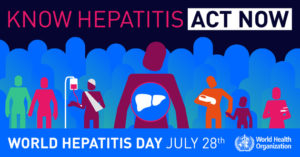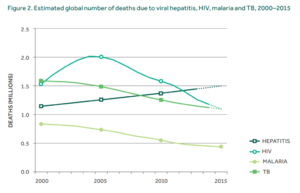
Enter World Hepatitis Day this Thursday, on 28 July. WHO, the Hepatitis Alliance and other organizations are using this official day to call for the elimination of this global disease. Coming on the heels of WHO’s newly released Strategy for targeting viral hepatitis, this day marks a new push to drastically reduce the number of deaths and infection rate.
What is hepatitis?
Here’s a quick refresher… The simplest definition is that hepatitis is a liver disease that causes the organ to become inflamed. There are many kinds and causes, but the primary focus for World Hepatitis Day is viral hepatitis, especially types B and C (HBV and HCV). Both viruses are often transmitted through infected blood via unsafe injections and medical procedures or from mother-to-child at birth, and to a lesser extent, through sexual contact. HBV and HCV account for about 95% of hepatitis deaths. WHO has a helpful FAQ and even a quiz on hepatitis.
There are a variety of reasons that make hepatitis a challenging and neglected health crisis. In some countries, social stigma and even criminalization of at-risk populations make it hard to track impact and provide appropriate responses. Barriers to treatment and vaccination are another serious issue, as the most promising and effective resources are rendered financially out of reach for many, largely due to patents/intellectual property issues and resulting high prices.
Perhaps the greatest challenge to effective responses to the disease is simply public awareness.
Perhaps the greatest challenge to effective responses to the disease is simply public awareness. WHO estimates that a mind-boggling 95% of people infected with viral hepatitis don’t even know they have it. Lack of diagnosis doesn’t mean the disease is a minor health issue. These viruses attack the liver and open a Pandora’s box of symptoms and hepatitis-related diseases, such as cirrhosis or cancer of the liver.
Without diagnosis, those with HBV or HCV can’t take the important steps needed to prevent transmission and to protect themselves from further liver damage. With appropriate treatment, 90% people with HCV can be quickly cured.

What is WHO’s plan?
WHO is setting big but important goals to beat viral hepatitis. The goal is ultimately for “a world where viral hepatitis transmission is halted and everyone living with viral hepatitis has access to safe, affordable and effective prevention, care and treatment services.”
Current targets seek to eliminate viral hepatitis as a major public health concern, reducing annual deaths from 1.4 million to less than half a million – all by 2030. According to the Global Health Sector Strategy on Viral Hepatitis, achieving these targets will require a “radical change in the hepatitis response.”
The Strategy on Viral Hepatitis document covers many details, centered around five key strategies. Of special interest is how these strategies tie into the SDGs framework, specifically for universal health care.
In a nutshell, the Strategy recognizes that the fight against hepatitis must be linked to other efforts – such as care for people with HIV – and anchored in a comprehensive public health approach. From vaccines for HBV to ongoing treatment for those infected, these action steps will only be realized within equitable and accessible health care settings.
The first strategic direction for eliminating hepatitis as a public health crisis is to “know your hepatitis epidemic.”
#NoHep = #KnowHep
Depending on which site you visit, the theme for this year is either “Elimination (#NoHep)” or “Know Hepatitis – Act Now.” This doesn’t appear to be a case of dueling themes, however: The first strategic direction for eliminating hepatitis as a public health crisis is to “know your hepatitis epidemic.”
In light of the relative lack of focus on the disease, #KnowHep and #NoHep are more than mere homophones. To face this disease, governments, health systems and individuals all need to understand the facts and develop the systems needed to understand more about this quiet but deadly global health crisis.
Published with permission from Inis Communication. Follow their blog for stories on global health and integrated development.
Hepatology, Medicine and Policy has launched with BioMed Central and is now accepting submissions on this and related issues. For more information, visit: www.hmap.biomedcentral.com.
Comments